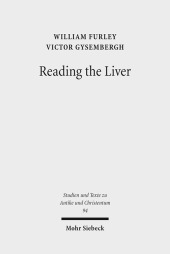 Neuerscheinungen 2015Stand: 2020-02-01 |
Schnellsuche
ISBN/Stichwort/Autor
|
Herderstraße 10
10625 Berlin
Tel.: 030 315 714 16
Fax 030 315 714 14
info@buchspektrum.de |

William Furley, Victor Gysembergh
(Beteiligte)
Reading the Liver
Papyrological Texts on Ancient Greek Extispicy
2015. X, 123 S. 231 mm
Verlag/Jahr: MOHR SIEBECK 2015
ISBN: 3-16-153890-0 (3161538900)
Neue ISBN: 978-3-16-153890-2 (9783161538902)
Preis und Lieferzeit: Bitte klicken
William Furley und Victor Gysembergh haben hier eine Edition mit Einleitung und Kommentar aller bisher bekannten Papyrus-Fragmente, die die antike griechische Eingeweideschau betreffen, zusammengestellt. Es sind Fragmente antiker Lehrschriften zum Thema, die zwar aus dem Ägypten der ersten nachchristlichen Jahrhunderte stammen, aber den Wissensstand früherer Zeiten im gesamtgriechischen Raum spiegeln. Interessant ist vor allem die geheimnisvolle Sprache der Priester auf diesem Gebiet, die die Schafsleber als Mikrokosmos des Menschen und seiner Umgebung darstellt. Die Autoren gehen insbesondere der Frage nach, ob und in welchem Maße die altgriechische Eingeweideschau direkt auf mesopotamische Vorbilder zurückgeht, wie oft in der Forschung behauptet wird. Die Ergebnisse werfen ein interessantes Licht auf antike Rezeptionsprozesse zwischen Griechenland und dessen östlichen Nachbarn.
William Furley and Victor Gysembergh bring together in a new edition the papyrus fragments of ancient Greek manuals of extispicy, that is, the inspection of animal entrails to predict the future. From art and literature we already know that the practice was important throughout the historical period in military and civic life, representing a widespread and respected way of taking the omens before embarking on any venture. Now, for the first time, the papyrological texts relating to this branch of the ancient mantic art have been collected, reedited and interpreted. The results show a refined and arcane art relating to the parts and appearance of the sheep´s liver expressed in a symbolic language all its own. In particular the authors examine the question of the degree to which this Greek pseudo-science derives from Mesopotamian extispicy, as has often been claimed.


